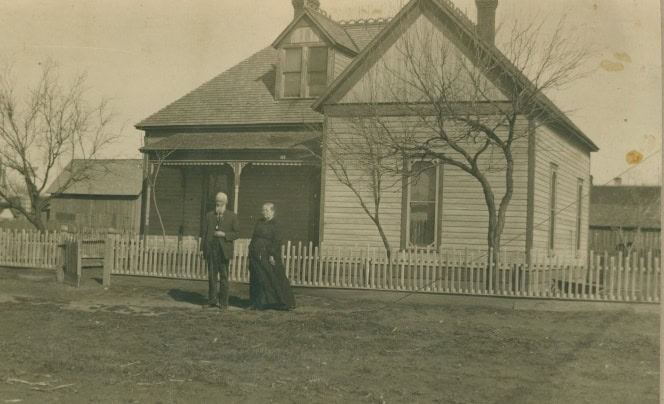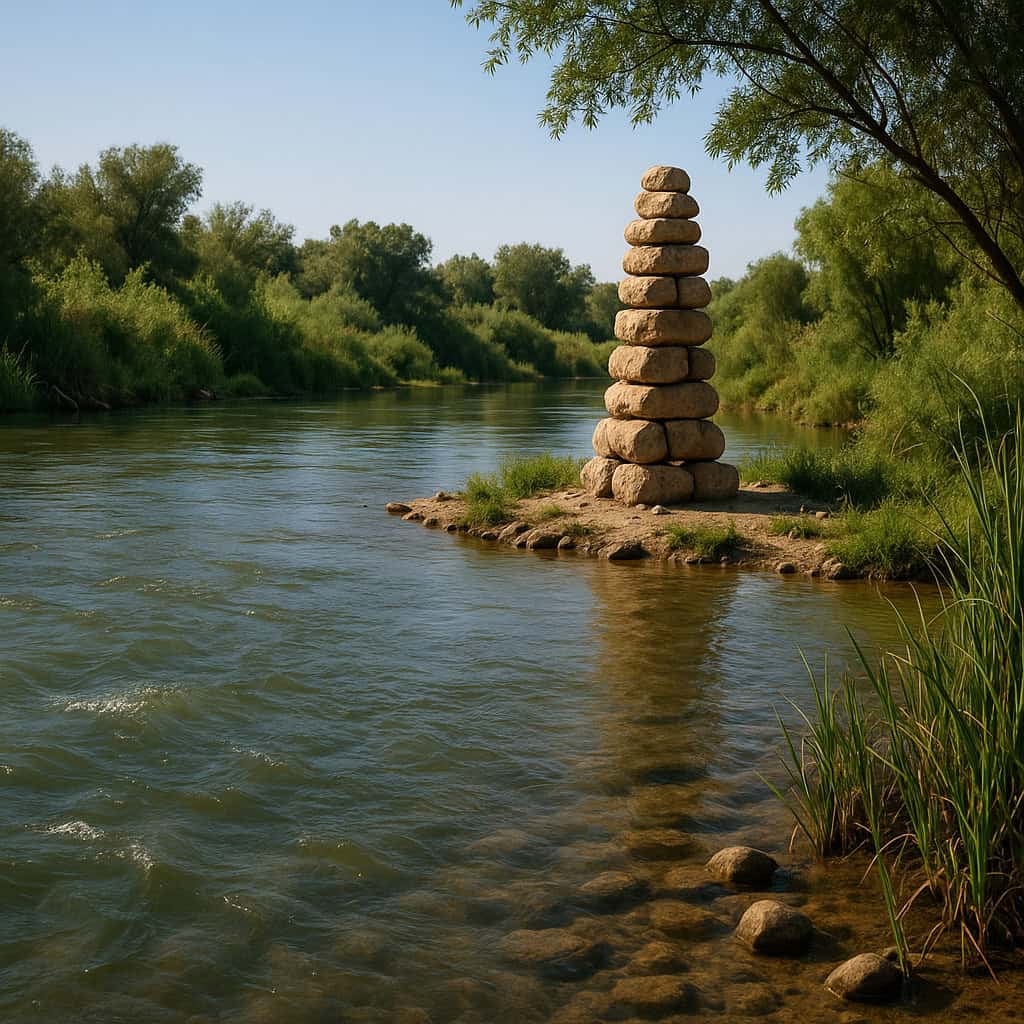Who are these people? I call this size of photo “Stick Figures” because you really can’t tell much about them. This was in my mother’s album, and she was almost 80 when I saw it and asked her questions. I did my best to write down everything she said.
These people were in their later years, obviously. Mother said they were her mother’s grandparents and called them “Grandpa and Grandma McDonald”. Since she was a toddler when he died, her only story to share was of Grandpa McDonald (in Merkel, Texas) on the porch as he was soaking his feet. About every 15 minutes or so, a car (this was the ‘Tin Lizzie’ era) would go by on the main road and, finally, he would say, “Where are they all going?” Boy, if he could only see I-25 today at rush hour!
OK, so this is my great-great grandfather – I chuckled but had no sense of “who” he was. And there were no other pictures of the two of them. And no one to share any first-hand knowledge.
But oh, my, later…..as I got more active in my genealogy work and went to the Family History Library – I had a grand discovery! And one that opened the door to a “robust Life Story” of my ancestor.
I learned that many cities and counties were urged at the time of the Bicentennial (1976) to collect and publish histories of their areas. Well, thank you – whomever had that urge and acted on it! As a result, I pulled the The History of Grayson County Texas off the Library’s shelves and went to the index. I looked – W. D. McDonald – that was one of the names on my list from that area.
I turned to the page with the names of both my great-great grandparents…and there, staring me directly in the face… was a close-up couple portrait of them!! And on the page were 2 smaller photos – one from earlier in their lives and one towards the end of their lives. Plus a full article of details that sketched a picture, much of which I would never have known otherwise. And they led me to these riches:
William Duncan McDonald enlisted in the U.S. Army at age 19 in Atlanta, GA in August, 1855 (he was born in South Carolina in 1835)
- Nope, not Civil War time yet; he served in the 1st Cavalry C – they went to Fort Leavenworth (KS) on the “Western frontier” – about when muskets were being replaced with rifles
- In 1855, Congress added 4 regiments (1st Cavalry C was one) –why? Treaties had expanded the US to the West and thousands of settlers headed for California and Oregon – so new military forts were needed to protect the migration.
- W. D. and his brother Marion McDonald served for 5 years together (1855-1860) – Ft. Leavenworth served as a staging area for a number of expeditions including campaigns against the Sioux in 1855 and the Cheyenne in 1857. I can just envision these brothers mounted on their horses fighting, escorting, building forts, serving the pioneers “moving west”. Oh, would I love a good story of their exploits!!
- While W. D. was discharged from the U.S. Army in August, 1860 near Ft. Riley, Kansas, he came through Grayson County, TX at some point, or right after discharge. Then BOOM! – he met and married Rebecca Elizabeth Cameron in September, 1861 in a little town called Pilot Grove in Grayson County (where he and his family are now buried – yes, I went there and took photos). And oh, would I love to know how they met and ALL the details, but that is pretty unlikely (sigh).
- BUT…war followed him. On Feb. 20, 1862, in Grayson County, Texas, he joined the Texas Cavalry, Confederate States of America. A Confederate “conscript law” was passed April 16, 1861. There were many objectors and feelings ran high – so I dug into the history a bit to understand the times. Even though a local election resulted in a vote to remain in the Union, fear of alleged Union sympathizers was high in North Texas. That fear resulted in a “Great Hanging at Gainesville, TX” in 1862 where 40 suspected Unionists were hanged with a jury picked from the crowd gathered there – an action taken largely under “mob pressure”. Yet, my ancestor had already joined the Confederates as did most other Grayson County men. I did think about his being born in South Carolina and joining the Army in Atlanta – he was a southerner. What were his thoughts? His hesitations? What compelled him to join?
- Helpful in my quest to know more were the detailed records kept of the Civil War battles (mostly by Union reporters). Since he was in the Texas Cavalry, as a 1st Lieutenant, Co. D 16th – I could look up the battles in which he served. And there were the company reports of his activity (scant info but interesting) kept by each unit within the Confederate Army.
- What did I learn? I will spare you many of the details, but it was a grueling time and I can hardly imagine what those soldiers lived through. What was the impact on them? How many deaths did they see? What conditions did they live with and fight under? And what did it do to W. D. McDonald – personally?
- Here’s the summary:
- His regiment formed in the spring of 1862 with about 1000 officers and men
- Started as Cavalry but later they “dismounted” (lost their horses) and got assigned to other infantry (lots of miles of marching)
- He fought in several battles from 1862 to 1864, and he was taken prisoner at Pleasant Hill April 1864. Oh, yes, I would dearly love to know more about his survival in that prisoner status – it appears he was there until the last record in his file showing him answering “call” and discharged April 17, 1865. That was a full year later and probably occurred as part of the general exchange of prisoners which happened near the end of the war.
- Just as a taste of what it was like, here is a description of the Milliken’s Bend battle – “The 16th Texas Dismounted Cavalry lined up on the left side of Richmond Road and were forced to cross ditches, stumble through vines and briars, and work through gaps in a line of hedges where Union soldiers were entrenched. Combat at the hedge was an intense and rare scene of hand-to-hand fighting with bayonets and clubbed muskets. One Union captain recalled, ‘…one member of the regiment and a rebel met and at the same instant plunged their bayonets into one another, and both fell dead on the works, both their bayonets in that position…it was a very hot place.’”
- And for a taste of their living conditions…. a Pvt Briscoe recalled “I was detailed and sent back to Texas (from Louisiana) to gather beef for the Confederate Government in 1864….My battles were against hunger. We were often fed on corn in the shuck, sometimes wheat bran alone, and sometimes bacon alone.”
- Gen. Lee surrendered April 9, 1865. Some of the records show that soldiers had been without pay for months before that. Luckily, Texas was untouched by invasion and were described as having difficulty at first believing the surrender could be true.
- BUT more difficulty was to come…..
- The protection of the frontier presented a problem. Returning soldiers had to surrender their arms leaving the community without protection from the Indians, outlaws, renegade whites and negroes. The Indians took advantage of conditions and continually made raids into the frontier settlements. Throughout 1865 and 1866, the entire extent of the frontier was in a state of terror and many counties became practically depopulated. It was two years before any measure of protection was given. How did my faithful, experienced Cavalry fighting soldier W. D. McDonald get through this time period? And protect his family? And farm?
- Despite an elected Governor of Texas in July, 1866, having made steady progress in restoring the State to order and peace, the U.S. Congress passed the reconstruction act in March, 1867. Result? Federal soldiers were sent into the south and military rule was established – removing the elected Governor and all county and district judges and other officers. They were replaced with local “radicals” even though it was hard to find enough loyal men in a county to fill the offices (i.e. men in sympathy with the reconstruction act). How did my soldier ancestor handle this militant and radical time? I wonder.
- Further difficulty – in Feb, 1868, Congress passed a law that every white man in Texas must take an oath that he had no part in the War before he would be allowed to vote. This, of course, excluded nearly all white men. Congress also made Texas change their Constitution to give the negroes the right to vote and hold office. The effect of these laws was to place the government in the hands of the newly freed negroes and men who had recently come into Texas from the North, called “Carpet Baggers.” There were many feuds and difficulties – and Grant was elected president so that 4 more years of radical rule was insured in Texas. How did my soldier ancestor, father and husband, disenfranchised and not allowed a say in local government fare during this time? I would love some stories here, please!!
- Finally, in 1870, Texas was re-admitted to the Union but the Texas governor went into complete control raising a militia and a state police. Many “unjust laws were passed…taxes soared and money squandered” plus he was said to have frequently used the militia to frighten and abuse innocent people. No surprise that the Ku Klux Klan was organized in Texas during this time. Yep, I want to know what W. D. McDonald thought about the KKK – what did the family experience in their local area – a small rural area in Grayson County?
- It took until 1873 for most of the ex-Confederates to be allowed to vote again – and they were victorious in all elections. The final struggle came in the next election in Dec. 1873 – but it should not surprise us that the old governor would not give up his office. He took possession of floors in the Capitol with negro militia and telegraphed President Grant for military assistance (which was refused). Finally, in Jan. 1874, the new Governor took possession and issued his statement: “Today for the first time since the disaster of the Civil War, Texas has a governor chosen by the people. Let the heart of the patriot throb with joy for representative government and ancient liberties so long lost are this day restored to the people of Texas”. A new state constitution was written and adopted in 1876 (and still essentially in place today). I know W. D. McDonald was by this time farming cotton, raising a family, and starting a weekly prayer meeting of a handful of men – what drove him? Where did he get his faith? What kept him faithful to this path during such chaotic times?
NOW, after getting this historical setting in place, I had tons of questions about how my great-great grandfather, W. D. McDonald, handled, thought about, lived in and around, all these events. So I matched up to the dates above these personal pieces:
…In 1870, when Texas was re-admitted to the Union, W. D. McDonald and his neighbor hauled baled cotton to a market in Texas and brought back lumber to build their new homes. So, he was farming cotton and evidently productive at it.
…In June of 1875 (eleven years after end of Civil War) he was one of four men who met at the Bethel school to begin a prayer meeting group. They had very few Bibles, so they used Webster’s spelling book for literature. They also had a Bible questionnaire. In 1877, another man joined them and they continued the organized prayer for a total of 7 years, never failing to have someone present to conduct the services. In 1884, Bethel Baptist Church was organized and grew to 37 persons, all living in the community.
…His 1925 obituary stated “He was a charter member of the Bethel Baptist Church and served them for many years as a minister. A farmer by occupation, he found time to preach the Gospel, and in the pioneer days of this section went from place to place, preaching to the people. He was loved and honored by all who knew him and was a useful man to his community.”
…He and his wife Rebecca had 14 children, losing four in childhood. Five girls and five boys lived to be grown.
My heart yearns to know more of the personal feelings – his and his wife’s, the children – and the stories and events that shaped them during these times. What did his time in the military, in the prison, do to shape W.D.’s later commitment to preach the Gospel?
I know my grandmother (daughter of one of W.D. and Rebecca’s boys) was a faithful Christian, played the organ at the Slaton Baptist Church for many years and LOVED Billy Graham! I imagine the family had some impact to bring her along that path. Oh, why didn’t I ask her more questions about all that before she left us?
OK – you KNOW my challenge to you!! Are you content to let your great-grandkids (or great-great grandkids) know you as a stick figure – and only in your later years?? Don’t you wish (as I do) that you had your great-great grandfather’s thoughts, important details and explanations of his life in a Life Story album?
MY Challenge: pull out some highlights and key events (along with some photos through ALL your years) to instead of a stick figure memory, give them a robust Life Story of your highlights, revelations, decisions and milestones to enrich them for generations to come !!
Click HERE to check out how to “Do A Life-Story Album in 3 Easy Steps” with me walking alongside you for support and encouragement.



